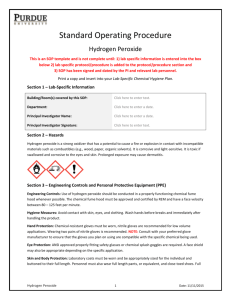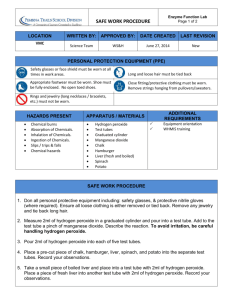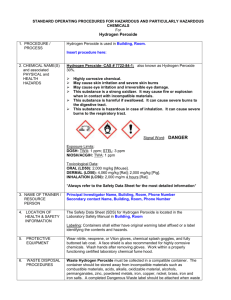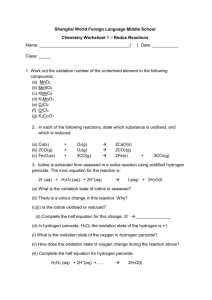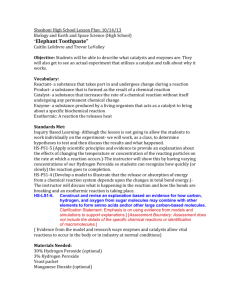Hydrogen Peroxide SOP
advertisement
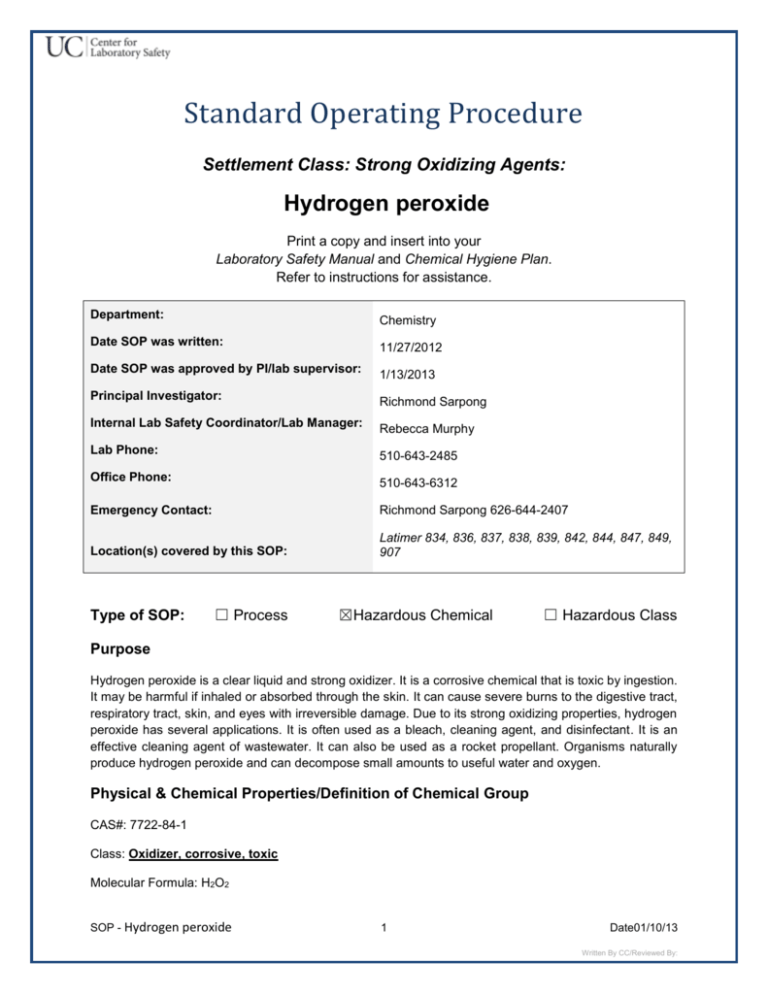
Standard Operating Procedure Settlement Class: Strong Oxidizing Agents: Hydrogen peroxide Print a copy and insert into your Laboratory Safety Manual and Chemical Hygiene Plan. Refer to instructions for assistance. Department: Chemistry Date SOP was written: 11/27/2012 Date SOP was approved by PI/lab supervisor: Principal Investigator: Richmond Sarpong Internal Lab Safety Coordinator/Lab Manager: Lab Phone: 1/13/2013 Rebecca Murphy 510-643-2485 Office Phone: 510-643-6312 Emergency Contact: Richmond Sarpong 626-644-2407 Location(s) covered by this SOP: Latimer 834, 836, 837, 838, 839, 842, 844, 847, 849, 907 Type of SOP: ☐ Process ☒Hazardous Chemical ☐ Hazardous Class Purpose Hydrogen peroxide is a clear liquid and strong oxidizer. It is a corrosive chemical that is toxic by ingestion. It may be harmful if inhaled or absorbed through the skin. It can cause severe burns to the digestive tract, respiratory tract, skin, and eyes with irreversible damage. Due to its strong oxidizing properties, hydrogen peroxide has several applications. It is often used as a bleach, cleaning agent, and disinfectant. It is an effective cleaning agent of wastewater. It can also be used as a rocket propellant. Organisms naturally produce hydrogen peroxide and can decompose small amounts to useful water and oxygen. Physical & Chemical Properties/Definition of Chemical Group CAS#: 7722-84-1 Class: Oxidizer, corrosive, toxic Molecular Formula: H2O2 SOP - Hydrogen peroxide 1 Date01/10/13 Written By CC/Reviewed By: Form (physical state): Liquid Color: Colorless Boiling point: 108 °C (226.4 °F) Potential Hazards/Toxicity Hydrogen peroxide is a strong oxidizer that has a potential to cause a fire or explosion in contact with incompatible materials. It is corrosive and light-sensitive. It is toxic if swallowed. It may be harmful if inhaled or absorbed through the skin. May cause burns to digestive and respiratory tract. May cause nausea, vomiting, diarrhea, damage to the red blood cells, stomach distension, bleeding of the stomach, cerebral swelling, and ulcer formation. May cause ulceration of nasal tissue, insomnia, nervous tremors, chemical pneumonia, unconsciousness, and death. It may be destructive to the tissue of the mucous membranes and upper respiratory tract. Cause skin and eye burns. May cause permanent eye damage. May cause central nervous system effects. Prolonged exposure may cause dermatitis CalOSHA Permissible Exposure Limit (PEL) – 1.4 mg/m3 Personal Protective Equipment (PPE) NOTE: Lab- specific information on PPE selection may be included in the Protocol/Procedure section. Respirator Protection Use a full-face respirator with multi-purpose combination (US) respirator cartridges as a backup to engineering controls. If the respirator is the sole means of protection, use a full-face supplied air respirator. Refer to 8 CCR 5144 for selection respirators. A respiratory protection program that meets 8 CCR 5144 must be followed whenever workplace conditions warrant use of a respirator. Respirators should be used only under any of the following circumstances: As a last line of defense (i.e., after engineering and administrative controls have been exhausted). When Permissible Exposure Limit (PEL) has exceeded or when there is a possibility that PEL will be exceeded. Regulations require the use of a respirator. An employer requires the use of a respirator. There is potential for harmful exposure due to an atmospheric contaminant (in the absence of PEL) As PPE in the event of a chemical spill clean-up process NOTE: Lab personnel intending to use/wear a respirator mask must be trained and fit-tested by EH&S. This is a regulatory requirement. Hand Protection: Handle with gloves. Gloves must be inspected prior to use. Use proper glove removal technique (without touching glove's outer surface) to avoid skin contact with this product. Dispose of contaminated gloves after use in accordance with applicable laws and good laboratory practices. Wash and dry hands. SOP - Hydrogen peroxide 2 Date01/10/13 Written By CC/Reviewed By: NOTE: Lab-specific and chemical-specific information on glove selection may be included in the Protocol/Procedure section. Refer to glove selection from the link below: For glove selection, go to: http://ehs.berkeley.edu/hs/63-laboratory-safety/94-glove-selection-and-usage.html http://www.ansellpro.com/download/Ansell_8thEditionChemicalResistanceGuide.pdf http://www.allsafetyproducts.biz/page/74172 http://www.showabestglove.com/site/default.aspx http://www.mapaglove.com/ Eye Protection ANSI approved, tight-fitting safety glasses/goggles. Face shields are also recommended. Use equipment for eye protection tested and approved under appropriate government standards such as NIOSH (US) or EN 166(EU). Skin and Body Protection Flame resistant lab coat, long pants, no skin exposed below waist, and closed-toe shoes. Hygiene Measures Handle in accordance with good industrial hygiene and safety practice. Avoid contact with skin, eyes and clothing. Wash hands before breaks and immediately after handling the product. Engineering Controls NOTE: Lab- specific information on engineering controls may be included in the Protocol/Procedure section. Work with hydrogen peroxide should be conducted in a chemical fume hood unless other controls are designated in the Protocol/Procedure section. Sash height should be kept low to avoid escaping fumes and provide a physical barrier. Good ventilation. First Aid Procedures Notify supervisor and EH&S immediately. Follow up with a call to 510-642-9090 to report the incident. If inhaled Move person into fresh air. If not breathing, give artificial respiration. If breathing is difficult, give oxygen. Consult a physician. In case of skin contact Wash off with soap and plenty of water for at least 15 minutes while removing contaminated clothing. Consult a physician. In case of eye contact Rinse thoroughly with plenty of water for at least 30 minutes lifting upper and lower eyelids and removing contact lenses. Consult a physician. Continue rinsing eyes during transport to hospital. If swallowed SOP - Hydrogen peroxide 3 Date01/10/13 Written By CC/Reviewed By: Do not induce vomiting. Never give anything by mouth to an unconscious person. If victim is conscious and alert, give 2-4 cupfuls of milk or water. Rinse mouth with water. Consult a physician. Special Handling and Storage Requirements NOTE: Lab-specific information on handling and storage may be included in the Protocol/Procedure section. Working alone Certain extremely hazardous operations should not be performed if the PI or Lab Safety Contact(s) are not present. Never work alone with extremely hazardous materials/operations. See the Protocol/Procedure section below for specific prohibitions (if any) on working alone. Precautions for safe handling: Avoid contact with skin, eyes, and clothing. Avoid inhalation and ingestion. Ensure adequate ventilation. Keep away from sources of ignition- No smoking. Conditions for safe storage: Keep container tightly closed in a dry and well-ventilated area. Opened containers must be carefully resealed and kept upright to prevent leakage. Recommended storage temperature is 2-8 °C. Store protected from light. Store away from combustible materials or other chemicals that are easily oxidized. Avoid alkalies, oxidizable material, alcohols, permanganates, zinc, powdered metals, iron, copper, nickel, brass, iron and iron salts. If not in use, hydrogen peroxide should be stored in a dark cool place. Once done using hydrogen peroxide, it should be immediately put back in the dark cool storage location. Store and transport hydrogen peroxide in secondary containment (for example polyethylene bottle carrier). Spill and Accident Procedure Chemical Spill Dial 911 Spill – Assess the extent of danger. Help contaminated or injured persons. Evacuate the spill area. Avoid breathing vapors. If possible, confine the spill to a small area using a spill kit or absorbent material. Keep others from entering contaminated area (e.g., use caution tape, barriers, etc.). Small (<1 L) – If you have training, you may assist in the clean-up effort. Use appropriate personal protective equipment and clean-up material for chemical spilled. Double bag spill waste in clear plastic bags, label and take to the next chemical waste pick-up. Large (>1 L) – Dial 911 and 510-642-9090 for assistance. Chemical Spill on Body or Clothes – Remove clothing and rinse body thoroughly in emergency shower for at least 15 minutes. Seek medical attention. Notify supervisor and EH&S immediately. Follow up with a call to 510-642-9090 to report the incident. Chemical Splash Into Eyes – Immediately rinse eyeball and inner surface of eyelid with water from the emergency eyewash station for 15 minutes by forcibly holding the eye open. Seek medical attention. Notify supervisor and EH&S immediately. Follow up with a call to 510-642-9090 to report the incident. Medical Emergency Dial 911 SOP - Hydrogen peroxide 4 Date01/10/13 Written By CC/Reviewed By: Life Threatening Emergency, After Hours, Weekends and Holidays – Dial 911 or go to the nearest emergency room.) Note: All Serious injuries must be reported to EH&S within 8 hours. Follow up with a call to 510-642-9090 to report the incident. Non-Life Threatening Emergency – Go to the Occupational Health Facility (OHF). After hours go to the nearest emergency room. Note: All serious injuries must be reported to EH&S within 8 hours. Follow up with a call to 510-642-9090 to report the incident. Needle stick/puncture exposure (as applicable to chemical handling procedure) – Wash the affected area with antiseptic soap and warm water for 15 minutes. For mucous membrane exposure, flush the affected area for 15 minutes using an eyewash station. Page the needle stick nurse \ and then enter your extension. After hours go to the nearest emergency room. Note: All needle stick/puncture exposures must be reported to EH&S within 8 hours. Follow up with a call to 510-642-9090 to report the incident. Decontamination/Waste Disposal Procedure NOTE: Lab-specific information on decontamination/waste disposal may be included in the Protocol/Procedure section. Wearing proper PPE, decontaminate equipment and bench tops using soap and water. Rinse used containers thoroughly with water before disposal. General hazardous waste disposal guidelines: Label Waste Hydrogen Peroxide waste should be placed in a chemically compatible container with a sealed lid and clearly labeled. Label all containers with the label provided at http://ehs.berkeley.edu/hm/279-new-hazardous-waste-program-hwp.html. See the EH&S Fact Sheet, “Hazardous Waste Management” for general instructions on procedures for disposing of hazardous waste. Store Waste Store hazardous waste in closed containers, in secondary containment and in a designated location Hydrogen peroxide solutions should first be treated with sodium thiosulfate and then placed in an appropriately labeled waste container. Double-bag dry waste using transparent bags. Waste must be under the control of the person generating & disposing of it Dispose of Waste Dispose of regularly generated chemical waste within 6 months. Call EH&S for questions Empty Containers o Consult waste pick-up schedule Safety Data Sheet (SDS) Location SDS can be found online (http://ucmsds.com) SOP - Hydrogen peroxide 5 Date01/10/13 Written By CC/Reviewed By: Protocol/Procedure CAS#: 7722-84-1 Preparation Know the location of the nearest fire extinguisher, eyewash, and safety shower before beginning work. Purchase hydrogen peroxide in smallest quantities suitable for the experiment design. The reagent slowly decomposed with time. Never work alone. Make sure there is another worker present who is also trained in the hydrogen peroxide SOP. Lab-Specific Information All work for this procedure is to take place in the designated fume hood. Wear proper PPE. Keep hydrogen peroxide containers tightly closed and stored in a dark cool place away from incompatible substances. Never shake or violently perturb hydrogen peroxide solutions. Hydrogen peroxide is usually obtained as a 30% diluted aqueous solution. Higher concentrations of hydrogen peroxide are available Procedure/Use Scale 1. Use in oxidations Use no more than 250 ml (commerciall y available 30% diluted aqueous solution) per reaction. Engineering Controls/Equipment Work with hydrogen peroxide should never be performed alone. All work using hydrogen peroxide must be performed in a ventilated fume hood. Eliminate ignition sources such as open flames, hot surfaces, steam baths, static electricity, and operation of mechanical and electrical equipment that is not intrinsically safe. Ensure proper grounding and avoid creating static electricity. Be sure to ground metal containers when transferring flammable liquids. PPE (eye, face, gloves, clothes) Eye protection: Wear tight-fitting safety goggles or safety glasses with side shields. Face protection: Wear goggles or fullfaced shield with goggles Gloves: Nitrile gloves (double gloved) for dilute hydrogen peroxide solutions and heavy nitrile or neoprene gloves for handling concentrated solutions. Extended contact should never occur. Clothing: Wear SOP - Hydrogen peroxide 6 Procedure Steps and Precautions Non-oxidizable solvents should be for reactions with hydrogen peroxide. Reducing agents can violently react with hydrogen peroxide so care should be used. 1. An adequate amount of hydrogen peroxide was measured with a clean and dry syringe. 2. Carefully add dropwise to a precooled reaction mixture. Hydrogen peroxide can be a potential explosive and thus temperature control over reactions with hydrogen peroxide are required. Exposure of the reaction to light should be minimized Date01/10/13 Written By CC/Reviewed By: A blast shield should be utilized when working with higher concentrations of hydrogen peroxide fire/flame resistant lab coat (100% cotton based); an acid resistant apron; cotton based clothing/attire; full length pants or equivalent; and close-toed, closeheeled shoes. as hydrogen peroxide can decompose upon exposure to light. Gaseous hydrogen can be emitted upon reaction between hydrogen peroxide and some metals and thus adequate ventilation (pressure bubbler on Schlenk manifold, or an equilibrating balloon) has to be used to prevent dangerous over pressurization. 3. After completion, an adequate amount of sodium thiosulfate should be added to reactions so as to neutralize the hydrogen peroxide. NOTE Any deviation from this SOP requires approval from PI. Documentation of Training (signature of all users is required) Prior to conducting any work with hydrogen peroxide, designated personnel must provide training to his/her laboratory personnel specific to the hazards involved in working with this substance, work area decontamination, and emergency procedures. The Principal Investigator must provide his/her laboratory personnel with a copy of this SOP and a copy of the SDS provided by the manufacturer. The Principal Investigator must ensure that his/her laboratory personnel have attended appropriate laboratory safety training or refresher training within the last one year. I have read and understand the content of this SOP: Name Signature Identification Click here to enter text. SOP - Hydrogen peroxide Date Click here to enter a date. 7 Date01/10/13 Written By CC/Reviewed By: Click here to enter text. Click here to enter a date. Click here to enter text. Click here to enter a date. Click here to enter text. Click here to enter a date. Click here to enter text. Click here to enter a date. Click here to enter text. Click here to enter a date. Click here to enter text. Click here to enter a date. Click here to enter text. Click here to enter a date. Click here to enter text. Click here to enter a date. Click here to enter text. Click here to enter a date. Click here to enter text. Click here to enter a date. Click here to enter text. Click here to enter a date. Click here to enter a date. Click here to enter a date. Click here to enter text. Click here to enter text. Click here to enter text. Click here to enter a date. Click here to enter text. Click here to enter a date. Click here to enter text. Click here to enter a date. Click here to enter text. Click here to enter a date. Click here to enter a date. Click here to enter a date. Click here to enter text. Click here to enter text. Click here to enter text. Click here to enter a date. Click here to enter text. Click here to enter a date. SOP - Hydrogen peroxide 8 Date01/10/13 Written By CC/Reviewed By: Click here to enter text. Click here to enter a date. Click here to enter text. Click here to enter a date. SOP - Hydrogen peroxide 9 Date01/10/13 Written By CC/Reviewed By:


